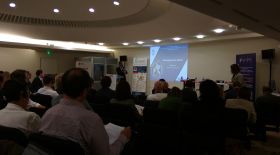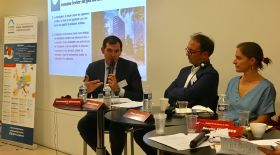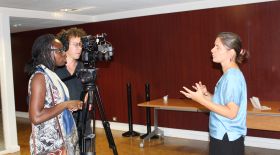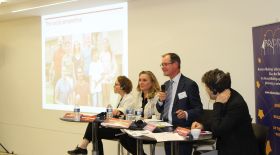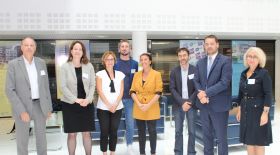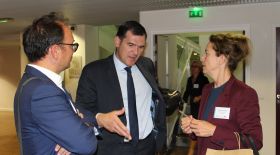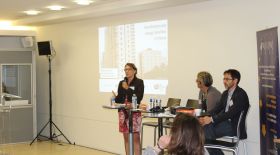Finding the land, financing energy efficiency and improving the city
Highlights from our ABRACADABRA International Workshop
Paris, 27 September 2018 | Published in Energy, Urban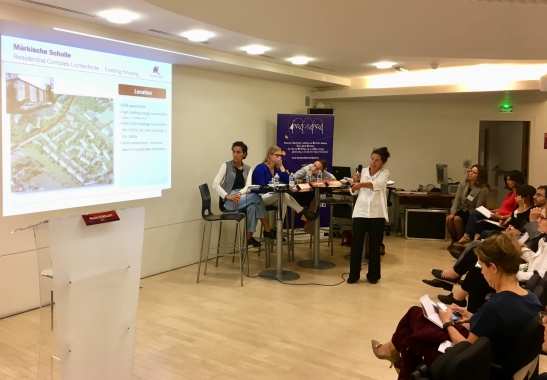
The 6th International Conference of the Horizon 2020 project ABRACADABRA took place on Thursday the 20th of September, in the building of Paris Habitat in Paris. The conference brought together experts and practitioners within architecture, urban planning, energy and housing provision, giving a podium for presentations of projects and initiatives and a platform for open discussion and exchange, focussing on: “finding the land, financing energy efficiency and improving the city”.
To welcome the attendees were Director-General of Paris Habitat Stephane Dauphin, moderator Sorcha Edwards, Secretary-General of Housing Europe, and President of Housing Europe Cédric Van Styvendael.
Opening the morning session “Strategic decisions for cities and social housing providers”, Cédric urged that, “We must have an approach focused on technical aspects, but we must also present a landscape of all the issues in order to show you all the ways in which the housing sector takes up these challenges related to energy.
36 billion euros of investment across Europe in fact! Our sector is very energy efficient and very much involved in the energy transition. While most certainly an environmental issue, this is also a matter of solidarity, in the fight against poverty.”
Keynote speaker Walid Oueslati from the OECD, presented and discussed, amongst other things, the recently published report “Rethinking Urban Sprawl: moving towards sustainable cities.”
Walid asked attendees, "We have been talking about urban sprawl more than eight decades - what is there that is new to say?"
Plenty it seemed! Walid urged that we need to remind ourselves of the difference between urban sprawl and urbanisation. And ask ourselves what is at stake? Employment, but also the environment - and average population density is significant for both. The case of Madrid proves an illustrative one: while the average population density increased by 40%, the land allocation towards very low-density areas increased by between 36% and 43%, signalling a potential mismatch of policy and reality?
A few policy goals outlined by Walid and the OECD included: Promoting socially desirable levels of urban density, densifying areas exposed to low density and decreasing fragmentation by connecting urban fabric patches.
Round table discussion: “The challenge of densification and energy transition in growing urban areas – impact on cities and social housing providers”
This session gave the opportunity for policy makers at the city and local levels to describe their current situations and to reflect on the challenges and opportunities provided by densification and energy efficiency measures.
Olivier Richard, head of International Affairs at Atelier parisien d’urbanisme kicked off this section by sharing with attendees a few developments happening in Paris: while in France, 60% of buildings were built before the first thermal regulation in the mid 70s, in Paris it is 80%. The city wants to locally produce 20% of energy, to halve energy consumption for housing, and more than 500 energy measures have been taken to this effect.
Jane Briginshaw, Director of Design England, gave us the lay of the land in London and spoke of a “suburban renaissance”, more specifically the “community and design-led renaissance”. London is going through a housing crisis, like many of our cities and there is a new London Plan, the existence of which is novel in itself (check it out here). Jane is seeing that a new vernacular and a new architecture is emerging, a large part of which is community-led.
Claire Roumet, Director of Energy Cities, gave a European perspective: towns and cities want energy transition, they want to understand their own needs, and how to do this. There are tangible solutions. Until recently, it was not feasible and was too expensive to produce energy locally. Production of energy is now more decentralised. There is demand-side management, the smart grid - we have moved away from the old narrative. The political context has totally changed.
So now, Claire asks: we have the same vision - but how do we get there together?
We need local-level, tailor-made services and projects. Autonomous self-production. A densification approach could be able to guarantee supply of affordable housing as well as being an opportunity to generate added value and energy efficiency.
Claire believes the future holds the “child-proof city”: children can move from place to place on their bicycle - school, park, bakery, home, green spaces. And when asked, "why do you not want cars?" the answer is not because they are dangerous necessarily... but "because they stink!"
Christophe Boucaux, Director for Development, L’Union sociale pour l’habitat USH, spoke from the level of national social housing provider and practitioner, sharing with us that social housing providers in France are committed towards energy efficiency and have been for a long time. Why? Not only to do with energy management, but also the fact that energy loads have an impact on the purchasing power of households. This is a question of energy poverty. Christophe was pleased to inform us that the social housing sector is 30% more efficient than any other tenure in France.
Afternoon session: challenges and solutions for social housing providers
Read MorePanel n°1: “the economics of densification through building extension – is there a business model for the social housing sector?”
First to share with us from this panel was Laura Vanhue, independent expert and consultant, who spoke on behalf of German housing provider Märkische Scholle Wohnungsunternehmen eG.
Specifically, Laura outlined the refurbishment project of existing housing in residential complex in Lictherfelde, a borough of Berlin. Consisting of almost 900 apartments, half of which were built in the 1930s and the other half in the 1960s, no sustainable renovation had been undertaken and high heating and energy consumption was an issue (approx. 170 kWh/[m² a]).
The standard narrative in Germany is that "Energy efficiency = higher rent", and Laura emphasised the importance of becoming “socially acceptable”: holding meetings and information sessions, open to all concerned members and residents. Other important measures for this project were distribution of “road map to restructuring”, renewal advisory board featuring equal representations, regular newsletters and social care.
Wrapping up with a bit of controversy, Laura said that: the EU regulations are too restrictive, as investors have to choose between investing in energy efficiency or a workable business model. The standards are too high and impossible to reach...
Sonia Dunlop, Senior Policy Advisor at SolarPower Europe, discussed “The importance of supportive legislative framework for renewable energy: What EU policy for PV on social housing?” first explaining why social housing is different for solar power, namely: low costs of capital and increased returns, long time horizons, economies of scale and major renovation projects, energy performance requirements.
So, what are some business model options?
Leasing – e.g. from building owner; Solar leasing company designs, invests and installs PV system on consumer’s roof; consumer pays monthly leasing fee over 10-20 years; System automatically gets passed to consumer after period OR option to buy at end of leasing contract; Solar leasing company can lease to tenant, housing association can lease to tenant; No up-front cost, savings from day on. But what happens when tenant moves on?) Onsite direct wire mini PPAs (power purchase agreements), Collective self-consumption and Crowdfunding.
However, policy barriers do exist, and one can find out more here: Solar Power Europe’s EU level PV financing reports: “EU-wide solar PV business models” and “Designing EU policy to encourage new solar business models”.
Sonia asked the audience did anyone ever consider that maybe … Small is Beautiful? There is a big potential for the small-scale in Europe: In 2017, approximately 60% of PV installations were installations below 500kW, In Germany, small-scale represents approximately 70% of total PV capacity, There is a high potential for rooftop PV: between +12 to +56 GW by 2022.
A dedicated framework for small-scale renewables would: preserve a proportionate approach for the small-scale by maintaining priority of dispatch and an exemption from balancing responsibilities for small-scale installations up to 500kW… until the market is ready, we need a competitive and liquid aggregation market, open electricity markets for renewables, transparent and fair curtailment rules.
Taïssa Bielyszew and Pina Avelli of La Société du Logement de la Région de Bruxelles-Capitale, SLRB presenting “A regional strategy for densification and social housing: the example of Brussels”.
SLRB covers the Brussels area, a region and 19 communes, currently 14,000 households are on the social housing waiting list and EUR1.3 billion has been earmarked for new builds of housing. The main issue, according to Taïssa and Pina, is that of land. Space in Belgium: a premium, there is not enough land and densification is topical, to say the least.
One response to land scarcity: look for and buy unused units in private sector e.g. disused commercial or industrial spaces. Student housing, intergenerational housing, kangaroo housing, community housing for older people. And mixed-use spaces, many times using prefabricated and modular (“plug and play" units) housing to do so.
SLRB are trying to find: even more and better systematic prefabricated processes. In terms of energy: in many of the tenders put out – companies are encouraged to have a goal of zero fossil fuel use. PV panels also encouraged, across roofs of all existing and future units, where possible.
Panel n°2: “How to increase acceptance for building extension and use of renewable energy solutions”
Isabelle Quet-Hamon and Laurence Wacquez, from Paris Habitat lead the final panel of the day, discussing, “Sustainable construction in the Parisan density: Citizen as actors.”
Parisien landscape: there are 180,000 households on the social housing waiting list, the city is is twice as dense as London or Berlin, with a property portfolio that is very protected (history and heritage) and a rigid regulatory context. However, a special waiver in terms of height exists (easier to build higher and vertical extensions) one of the reasons why Parisians say, "nobody builds new in Paris, we build on top!" The current Parisian housing policy is quite ambitious, sustainable housing is a priority, as well as quality services and environmentally friendly policies.
One major project that Paris Habitat is developing is an entire new district: conversion of an old “royal mirror factory” to Reuilly Barracks to a 600-unit development. They are recovering and reusing materials, creating a public garden and opening up the development to connect it to the rest of the neighbourhood.
Most significantly, the project is owned and managed by the neighbourhood. From the outset, Paris Habitat took an inclusive and bottom-up approach, holding workshops, work groups, open public meetings and listening to the existing community.
The results? Not one appeal, a very rare occurrence! Paris Habitat urged that a comprehensive consultation process is essential, as well as successfully communicating that: 1. there is nothing "wrong" with social housing, 2. high quality social housing exists.
Mårten Lilja, Vice President Riksbyggen and board member of Housing Europe, told us about “Creating social acceptance through sustainability: the example of Sweden”, specifically the story of Skarpan in Linköping, where 282 rental apartments built during period of 1965 – 167, were in real need of renovation.
Actions taken involved: refurbishment and renovation of the existing apartments, densification by the construction of 150 new apartments, installation of elevators, energy optimisation, preservation of “popular details from original furnishing”, as well as construction of new day care facility and older person’s home. Tenants reported positive and regular contacts, correspondence and meetings with the Riksbyggen team.
The conclusion of the project? Energy: Before 160-170 kWh/sqm and After 90 kWh/sqm, sustainable buildings, satisfied tenants, increased value, raised standard for the entire area, a better living environment in general.
Bernd Hunger from GdW presented “building in neighbourhoods with additional floors: the German perspective”. He shared with us four ways to "create more space": 1. Add floors, 2. build extensions, 3. inserting new buildings, 4. replacement - demolition and new construction. Principles learned include: necessary to create better quality for existing quarters, a basis for acceptance; densification can widen diversity of living conditions; must handle with respect existing residents and spatial situation; must involve neighbourhood from early stage and continuously.
Thomas Vallet of Est Metropole Habitat (EMH) wrapped up the panel presentations, and described to us the case of the “Holistic renovation of social housing in a suburban area: the example of Pranard”. This neighbourhood had a “bad image”, few services, and an ageing population who was very attached to their neighbourhood and green spaces. So, a major project involving demolition, restructuring, rehabilitation and construction of housing units was announced. Construction of new units involved 4 houses on a roof (wooden structure), and 17 as extension (classic concrete structure). Which benefits for tenants? Revenue related to photovoltaic production will reimburse part of the common charges, creation of district heating and the first steps towards a zero charge building.
Last but not least: The ABRACADABRA Policy Recommendations
At the end of a very educational and productive day, the ABRACADABRA partners voted on a series of policy recommendations by the members of the ABRACADABRA project. Before this, however, two experts shared some of their thoughts.
Waltraud Schmid, of Urban Innovation Vienna, informed us that:
- Vienna is growing by 30,000 people each year. Half of the people arriving, find homes in the existing city, however, 13,000 apartments are needed each year. An emergency measure was brought in by City of Vienna: creation of a new "subsidised housing zone", in response to high and increasing price of land.
- Some suggestions and offerings from Waltraud: Cities need to do proper energy planning along with urban planning. During renovation: necessary to consider mobility, energy and the surroundings of the building. We should consider unconventional builds and schemes: on top of supermarkets, e-car sharing within estates. And as always, best results come from projects where tenants have been involved from the very beginning. One happy side-effect of this is community building.
Annarita Ferrante, ABRACADABRA Project Leader, and Associate Professor in the Department of Architecture at the University of Bologna, spoke of her happiness with the evolution of project. She described how, in the beginning, the project mainly focussed on the private sector at the building. Now, it is an exciting prospect to focus on social housing sector.
Why? The social housing sector is the only sector that could lead process to promote socially desirable levels or urban densification and building additions. It is one of the privileged sectors to deal with the social services and open green/environmental spaces in urban areas and, it is the main interlocutor with public body, who is in charge of urban regulation.
Suggestions by Annarita include that the European Commission should waive existing regulations in terms of urban capacity, standard limits and ownership constraints related to land use.
Finally, Julien Dijol, Deputy Secretary General and Policy Coordinator at Housing Europe, presented and facilitated the voting session of policy recommendations for social housing providers and city/local authorities that the ABRACADABRA team and project will adopt.
Some of these included, for example:
- Building extensions can boost supply, improve energy systems and lower living cost.
- A co-productive decision-making process with the active tenants’ involvement is crucial for a successful project.
- Loans and grants should be flexible enough to cover the whole range of the intervention needed.
- Building codes and urban planning should favour increase of height of buildings & flexible architectural prescriptions. (this one proved controversial....!)
- Public buildings with a flat roof shall be disposable for the creation of new residential units. (also, controversial....)
- Renovation/Construction companies should with integrated solutions to building extension.
Highlights from the Q and As throughout the day
The major, if not the main, issue: communities refuse these types of initiatives, they do not want to densify! There can be a lot of opposition. Density frightens people. However, people might actually like most qualities related to density - the “feelings” of it.
We must therefore consider “Density as we count it” and “density as we feel it”.
Issue of car park spaces: Must solve this - do trade offs if necessary: “You can have either a carpark, or a huge kitchen!” If you tell people “you are not allowed to have a car park space” they still own their car, and will park their car somewhere – on the pavement for instance.
As far energy upgrades and tenants: the rent they pay is all inclusive. And so any risk is on the landlords. Which means that we have to have a good mastery of technology. Landlords have to acquire enough skills to know how to manage these facilities and amenities and installations, and so this should be a prerequisite.
We need a balance of energy performance and production of renewable energy. Combine the envelope and the production of energy?
Tax rebates for nZEBs: is this a type of discrimination? What about historical buildings in a city? Should not only be for nZEBs.
